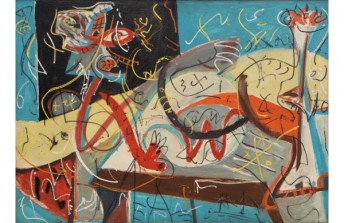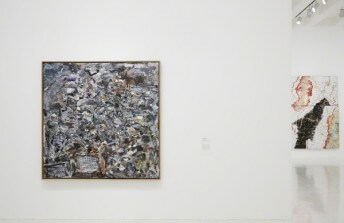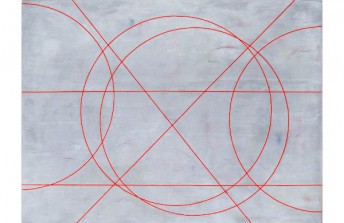The Legacy of Trailblazer of Abstract Art, Gillian Ayres
Apr 18, 2018
British abstract painter and printmaker Gillian Ayres has died at age 88. Her death leaves an empty spot in the world of art, and also in the worlds of education and role-modeling. Ayres was easily one of the most charismatic, confident art teachers in Britain, largely due to her total embrace of non-conformity. She taught at the Bath Academy of Art from 1959 through 1965, lectured at Saint Martin’s School of Art, London from 1966 through 1978, and then in 1978 she became the head of the Painting Department at the Winchester School of Art. That last job was more of a managerial post than a teaching one. She left it after constantly struggling with the school administrators over how, and in fact whether at all, to manage the department. Ayres was a believer that art education would be better served without some office being in charge of it. Though that was her last official academic position, Ayres kept on teaching by her example. She was a role model for the importance of having principles and vigorously standing by them. Her principles included immense generosity to her students and friends (whom she often put up in her home), a love for champagne and cigarettes (which she indulged in until the end), and complete hatred for the members of the so-called Euston Road School, a collective of traditional realist artists who were opposed to avant garde and abstract art. Her devotion to abstraction helped inspire countless other British abstract artists, and helped reverse the institutional prejudice against abstraction in schools, galleries and museums. The legacy she hoped to leave behind can be summed up in a statement she made in an interview with the Financial Times in 2015. She said, “People like to understand, and I wish they wouldn’t. I wish they would just look.”
Shapes and Spaces
Ayres finished art school in 1950 and took a job as a gallery assistant. She kept the position for six years part-time while also painting. She has said that in these early days of her career she was influenced largely by Jackson Pollock and the Abstract Expressionists. However, what inspired her most about them was not their metaphysical tendencies, i.e., their attempts to connect with a primal well of deep, hidden emotion. Rather, she was inspired by their working methods, which seemed to her to be free and experimental. She adopted the technique of working on the floor and using loose, lyrical movements while painting. Many of her works from this time could be described as action paintings. They frequently include splattered and dripped paint, gestural brush marks, and large, energetically applied fields of color.
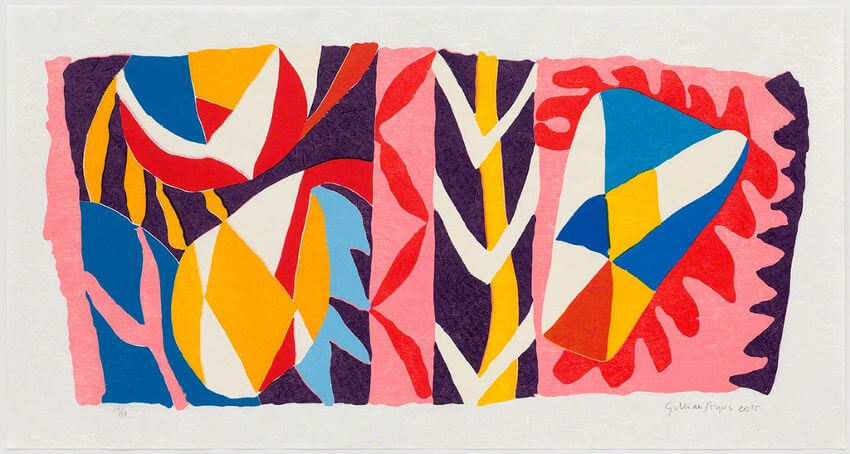
Gillian Ayres - Achiote, 2015, Woodcut on 75gsm Unryu-shi Japanese paper, 33 3/5 × 64 2/5 in, 85.4 × 163.5 cm, photo courtesy Alan Cristea Gallery, London
Simultaneously to her exploration of “all-over” style action painting, Ayres also showed interest in the straightforward exploration of shapes and spaces. Many of her paintings from the 1950s and 60s contain loose compositions of circles, squares, and other geometric, or quasi-geometric shapes. The shapes frequently seem to hover around each other in a void. These paintings are purely abstract, but not in the sense that Ayres “abstracted” them from the natural world. Instead, she simply sought to create compositions that have no narrative or figurative content whatsoever, because she believed in the potential for abstract images of shapes interacting in space to be “heady.” In other words, she felt such pictures could be intoxicating. She believed this quality was vital so that people could simply enjoy looking at her art without feeling pressure to think logically about it, or even to engage their intellect at all.

Gillian Ayres - Illyria, 2017, Woodcut on 75gsm Unryushi Japanese paper, 36 1/5 × 40 9/10 in, 92 × 104 cm, photo courtesy Alan Cristea Gallery, London
Indulgent Color
In addition to her love for shapes and spaces, Ayres was an enthusiastic lover of color. She once said, “To me, colour in art is wonderfully indulging.” She wanted people to drink her paintings in. She considered them feasts for the eyes. She said, “I don't see why you shouldn't be filling yourself up, making yourself happy—enjoying yourself, feasting on beauty.” As much as this sounds like a harmless point of view today, there was a time when it caused Ayres to be deeply mistrusted by British audiences. That mistrust culminated in 1957, when after being included in the exhibition Metavisual Tachiste Abstract - Painting in England Today, Ayres was contracted to paint a mural in the dining hall of a London school. Almost as soon as she finished the mural, school administrators ordered that it be covered with wallpaper. Only decades later, after Ayres was famous, was the mural rediscovered in almost perfect condition under the wallpaper.
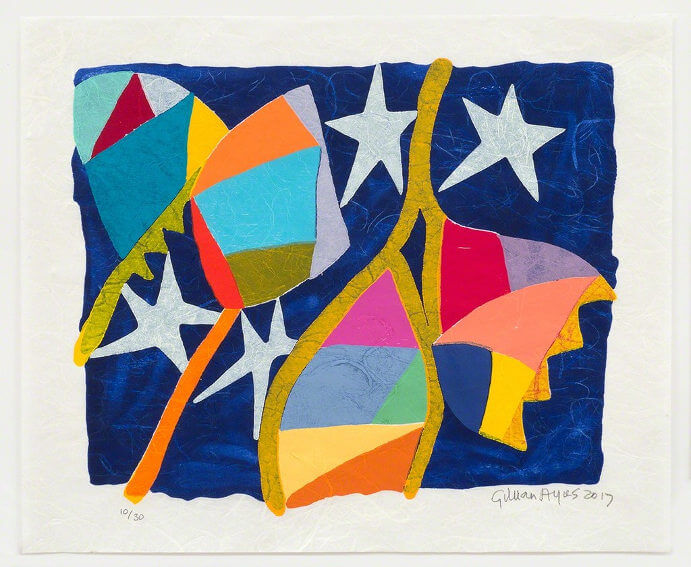
Gillian Ayres - Thuban, 2017, Woodblock on Unryushi 75gsm paper, 18 4/5 × 22 4/5 in, 47.8 × 57.9 cm, photo courtesy Alan Cristea Gallery, London
The affection Ayres had for color as subject matter is evident throughout her career. As her compositions became less lyrical, less gestural, and more structured and architectonic with time, her love of color only grew stronger. By the 1980s she had developed a somewhat whimsical, celebratory aesthetic vision based on vibrant, light colors and biomorphic shapes. These alter works are seemingly inspired by nature. Some people suspect that is because during this time in her life Ayres moved with her family to a coastal rural community in Wales. She has said that the conditions there, especially the landscape, were a great influence on her. However, she always insisted her work was not abstracted from nature, nor pared down from images of the countryside. In some ways, the latest paintings Ayres made are reminiscent of the cut-outs of Matisse. Both artists adopted a similar color palette late in their careers, and both developed a similar sense of spatial relationships. Except that whereas Matisse proudly hoped to evoke the shapes and forms of the natural world in his late work, Ayres remained dedicated until the end that her works were not based on anything. They are just images of colors and shapes in space without meaning beyond themselves, offering pure pleasure to viewers courageous enough to indulge in their beauty.
Featured image: Gillian Ayres - Heligan 1, 2011, Woodcut on Unryu-shi Japanese paper, 30 7/10 × 45 7/10 in, 78 × 116 cm, Edition of 18, photo courtesy Alan Cristea Gallery, London
By Phillip Barcio


